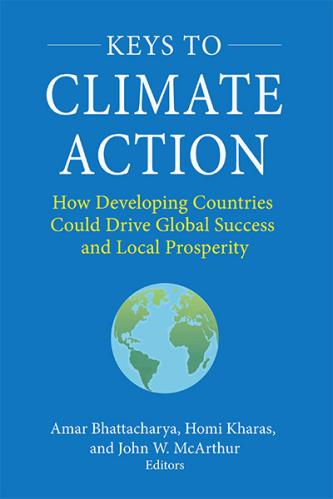Below is a viewpoint from the Foresight Africa 2023 report, which explores top priorities for the region in the coming year. Read the full chapter on climate change.
 Decarbonization at a global level is happening and will be stepped up as the impacts of climate and weather extremes threaten social and economic systems worldwide. Already, we are seeing the deployment of huge quantities of renewable energy in advanced economies, and investments earmarked to make green energy transitions feasible. Countries that lag behind in low carbon technological innovations stand to lose, both in terms of the health and social co-benefits that come with the deployment of clean infrastructure, as well as the economic co-benefits that come from manufacturing the technologies of the future. Africa needs to pay close attention to the opportunities that lie.
Decarbonization at a global level is happening and will be stepped up as the impacts of climate and weather extremes threaten social and economic systems worldwide. Already, we are seeing the deployment of huge quantities of renewable energy in advanced economies, and investments earmarked to make green energy transitions feasible. Countries that lag behind in low carbon technological innovations stand to lose, both in terms of the health and social co-benefits that come with the deployment of clean infrastructure, as well as the economic co-benefits that come from manufacturing the technologies of the future. Africa needs to pay close attention to the opportunities that lie.
As the world pursues low emissions ambitions, the demand for critical minerals including lithium, cobalt, and nickel will increase six-fold by 2040. Africa holds considerable resources vital to a clean energy future, which includes commodities essential in renewable energy generation technologies and battery-associated materials. This presents transformative potential for Africa’s economic growth, employment, welfare, and wider sustainable development. For example, the Democratic Republic of Congo (DRC) is known to have 50-70 percent of global reserves of cobalt, and South Africa and Gabon have nearly 40 percent of global manganese reserves. Countries such as Zimbabwe and Namibia have among the largest reserves of lithium globally.
If Africa is to avoid repeating past errors, its role in the global decarbonization journey needs to be broadened beyond mineral extraction.
However, if Africa is to avoid repeating past errors, its role in the global decarbonization journey needs to be broadened beyond mineral extraction. Converting raw resources into tangible value-added opportunities in downstream activities is crucial. It may not be feasible to localize all segments of the value chain in the short-term, but serious planning and preparation are required to mitigate the risks of having Africa locked out of the green manufacturing value chain. This requires bold industrial policies and strategies to create domestic demand, opportunities for value-added exports, and doing away with the business-as-usual model of mineral and raw material extraction.
Some of these policies and interventions could include:
- African governments must invest in national capacity to produce high quality human resources and institutions. Countries that have the capability and capacity to navigate the changing technological and regulatory environment are well positioned to spur greater investment, and to develop local content policies that are in line with their capabilities and aspirations.
- Regional industrial policy coordination: A single country cannot hope to industrialize without stronger regional synergies. As such, building cross-border, regional value chains can offer a pragmatic framework to boost collaboration and attract investment in downstream activities. This would involve trade and cooperation between countries based on their comparative advantage, such that some countries provide key mineral inputs while others manufacture technologies
- Develop justice-oriented national industrial policy: The renewable energy sector offers a system-wide opportunity for industrialization. However, this needs to embrace equal opportunities and an equitable distribution of the benefits of industrialization to all stakeholders. At the heart of this is a governance framework that engages all stakeholders—including governments, mining companies, shareholders, investors, and affected communities— in a constructive dialogue to shape the direction and character of the industrialization path.







Commentary
Global decarbonization: Industrial opportunities for Africa
May 19, 2023